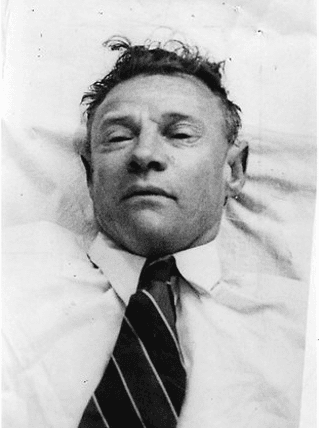
The Tamám Shud Case – The Dead Man on Somerton Beach
December 1, 1948 – Somerton Beach, Adelaide
At dawn, passersby noticed a man slumped against a sea wall. He looked like he was sleeping.
But he wasn’t.
The man was dead. He had no wallet. All the tags had been cut out of his clothes. He carried no identification, no money, no hat — unusual for 1948 — and wore a pressed suit in the middle of the Australian summer.
His body showed no signs of struggle or trauma.
Autopsy showed no clear cause of death — though his spleen was enlarged and his stomach had blood, which could suggest poisoning. But no poison was detected.
The First Mystery: Who Was He?
Police circulated his photo across the world. No one came forward. His fingerprints matched no records in Australia, the UK, or the US.
He was a man without a name.
They called him “The Somerton Man.”
The Clue in His Pocket
Months later, a tailor discovered a tiny hidden pocket sewn into the man’s waistband. Inside was a rolled-up scrap of paper that simply read:
"Tamám Shud"
It was identified as the final page from a rare copy of The Rubáiyát of Omar Khayyám, a book of Persian poetry. The phrase roughly translates to:
“It is finished.”
“The end.”
Or… “It is done.”
Was it a suicide note? A message to someone? A signature?
The Book, the Code, and the Phone Number
A man came forward saying that around the time of the death, he found a copy of The Rubáiyát in the back seat of his unlocked car — near the beach.
Inside that book:
- The Tamám Shud page had been torn out — a match to the one in the man’s pocket
- Scrawled on the inside cover was a series of capital letters — a mysterious code:
nginxCopyEditWRGOABABD MLIAOI WTBIMPANETP MLIABOAIAQC ITTMTSAMSTGAB
To this day, no one has cracked it.
Also inside the book: a phone number. It led to a woman named Jestyn, who lived just minutes from where the man’s body was found.
The Woman Who Knew Something
Police interviewed Jestyn (real name: Jo Thomson), a nurse and ex-army employee. When shown a plaster cast of the Somerton Man’s face, she reportedly:
- Visibly recoiled
- Was “shocked to the core”
- Claimed not to know him
- But also denied ownership of the book — despite evidence to the contrary
She had once given a copy of The Rubáiyát to Alf Boxall, a soldier she had known during WWII. Police feared Boxall was the dead man — but they found him alive.
His copy of the book? Still intact — with Tamám Shud still in place.
So who was the man on the beach?
Theories That Still Haunt
🕵️ 1. Suicide
Many believe the man took his own life via untraceable poison, perhaps out of heartbreak. But why cut the labels from his clothes? Why the code? And why choose a phrase in Persian?
🕶️ 2. Spy Game
The Cold War had just begun. Adelaide was near a secret weapons research base. The code, the anonymity, and the connection to multiple intelligence-connected figures suggest the Somerton Man may have been a spy.
Even Jestyn had worked in wartime communications.
💔 3. A lover discarded
Did he travel across the world for Jestyn — only to be rejected? Was Tamám Shud his farewell?
She later had a son who bore a remarkable resemblance to the Somerton Man, sparking rumors of a secret affair or child.
A Face with No Name
He dressed well. He died without violence. He left behind a poem — and a code no one can break.
In 2022, Australian authorities exhumed the body to run DNA analysis.
In 2023, University of Adelaide researchers proposed his identity was Carl “Charles” Webb, a man from Melbourne with no known grave — but this is still debated, and the full mystery remains unsolved.
Tamám Shud – It Is Finished
Or is it?
The Somerton Man still haunts Australia — a cipher in a suit, lying on a beach, his secrets stitched beneath his waistband.